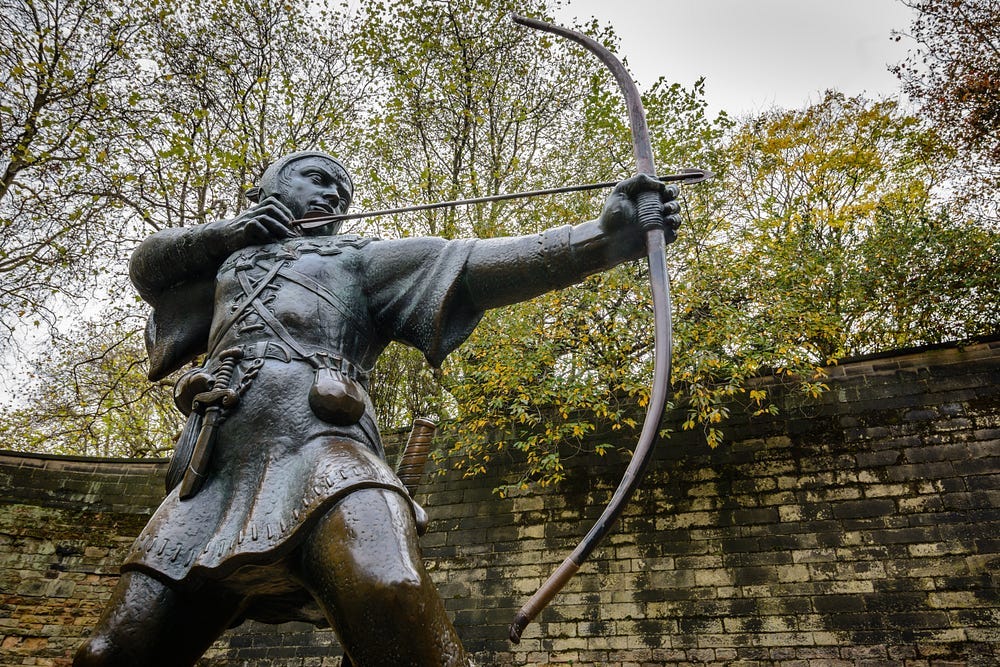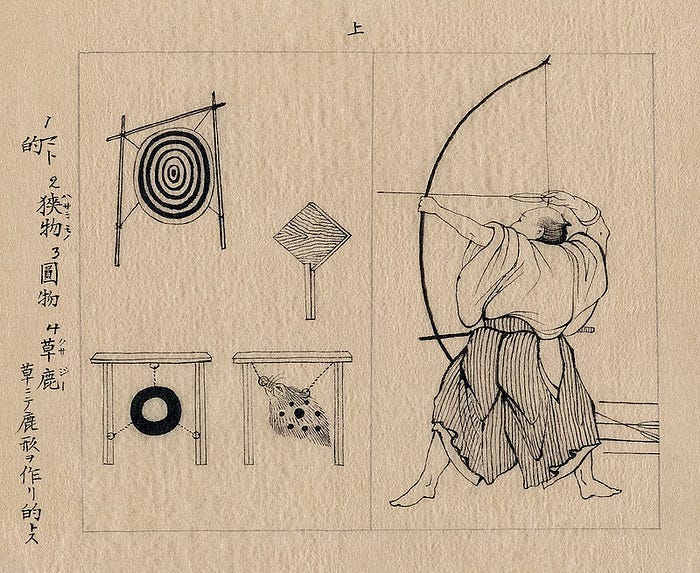How Ancient Cultures Improved Their Lives With Archery
This old skill can teach us wisdom today.

Archery is universal. It’s been practiced around the world from ancient Greece to Japan. Anywhere you travel throughout the globe, most ancient cultures learned the practicality of the bow. Obviously, it’s an excellent way to kill and hunt. It takes one away from danger and uses leverage and range.
According to archeologist Luvsannorov Munkh, the bow can be made of the simplest materials, like wood and sinew from animals. However, a complex Mongolian composite bow could take years to make, be fired accurately on horseback, and have a range of five hundred meters. Although some might call it a simple tool, Munkh explains the Mongols worked on their bow design for 3,000 years.
But the bow isn’t just a tool or weapon; it’s beyond this. Archery is an artform that requires training and skill over endless years. This life-long skill could very well be the difference between life and death. As a result, the ability to use a bow gained an important place in most societies for a reason.
As can be imagined, an art this important took on an ethereal quality. The lessons learned training with the bow became part of philosophy for countless cultures — it was inevitable. Beyond being a tool, the bow would be used to teach humanity how to live.
In our present age, however, we view the bow as archaic. It’s an anachronism which serves no purpose when pizza can be delivered anywhere, and we no longer need to hunt. Although we may have gained greater technology, we lost one of our primary teaching tools for life. But it may not be too late to relearn some ancient lessons.
The Bow’s Influence On Teaching Wisdom
“In ancient India, the bow symbolized the human being; each of its two ends signified Man’s higher and lower self, or his heavenly and earthly nature. There is always a string which connects these two ends which needs to be tied with just the right tension in order to use it effectively. As the archer draws the arrow, he brings both ends of the bow closer; they act as one, and enable the release of the arrow, an expression of his inner being, his Will.”
— Vineet Lalan, The Acropolitan Magazine
In his article, Vineet Lalan goes into some of the significant ways the bow is used as a teaching tool in India. He says its shape is employed to describe the nature of man. In addition, he mentions a story of archery as a metaphor to teach the value of concentration in the Indian epic of the Mahabharata.
In the story, the hero Arjuna is lined up with other archers to aim at a bird-shaped target in a tree. The teacher asks each student what they see as they aim. All give descriptions of the world around them and are asked to sit down. The teacher indicates they failed before they even fired the arrow. However, Arjuna tells his teacher he only sees the bird and is allowed to shoot, hitting the target.
The bow is also used as a teaching tool for the Lakota Tribe as well. In an interview with NPR, author Joseph Marshall III, speaks of its significance. As a child Marshall’s grandfather demonstrated how to make the tool by hand, teaching him life-changing skills. Obviously, the time and work built a connection between himself and his older relative too.
His grandfather and grandmother also used the function of the bow and arrow as a teaching tool. He explains the bow is described as feminine and the arrow as masculine. Both are needed to make the device and greater world function. It was the type of lesson not taught in school which became more vivid with the bow in his hand. Archery also passes on the culture of his people.
Christian teaching likewise uses archery as a frame of reference. The Greek word hamartia, used in archery, means to miss the mark. Consequently, many teachers today use this term to describe sin. Your aim is off and you’re not achieving morally what you should be shooting for.
The Romans, Stoicism, And Archery
“The good Stoic, Antipater suggested, is like an archer: he does everything he can to hit the target, but his happiness does not depend on whether he hits the target or not. What matters is shooting well, for whether the arrow hits the target or not depends on other factors outside of the archer’s control.”
— John Sellars, Stoicism and the Art of Archery
The ancient Romans also made use of the bow to pass on lessons of wisdom. John Sellars in his article lists references by Cicero where he mentions the best one can do in life is aim at a target to the best of their ability. Hitting the target is “to be selected but not sought.” Moreover, the stoics also use archery as a prime method to teach their idea of the dichotomy of control.
In this teaching, the stoics explain there are things in life which can and cannot be controlled. An archer can take aim at a target and fire their arrow, however, once the arrow is let go, fate can take over. A gust of wind can deflect the arrow, or the target might just move.
This is very much like life. We can take all the preparations necessary to make something happen, but things out of our control can sink the effort. It’s up to us to accept what’s in our control and what’s not. Just like Cicero describes, many times a target is to be selected but not sought. Therefore, the effort to acquire the target in itself may be a worthy goal.
Many Romans would use the bow regularly and as such be familiar with these ideas. Therefore, the bow for the stoics is a prime tool to teach ethics and ideas which themselves have no physical form.
The Far East, Zen, And Archery

In the book Zen In The Art Of Archery, Eugen Herrigel describes his time in Japan learning how to use a bow. Counterintuitively, he came to realize archery isn’t a sport there, it’s treated like a Zen religious ritual or art. He describes the practice as “spiritual exercises and whose aim consists in hitting a spiritual goal, so that fundamentally the marksman aims at himself and may even succeed in hitting himself.”
He says the medieval art is no longer needed as a hunting or killing tool. However, since that function is gone, now archery is almost purely focused on the self instead of “bloody contests”. In fact, hitting the target wasn’t the ultimate desired outcome — the form of the shot is what’s important.
Herrigel learned to clear his mind and not focus too much on the target. If one tries too hard, the shot isn’t smooth, and they miss. As a result, the best way to make a good shot isn’t to overly concentrate on hitting a bullseye. As he became better with the bow, he consequently became better with himself. As his shooting improved, his teacher never complimented him on the skill, yet said he’d become a different person. In the end, that is the purpose of their form of archery, it’s a struggle with the self.
An Ancient Art Can Pass On Modern Wisdom
In our culture of instant gratification, the slow path of archery may be torturous to many. It takes countless hours to master and could take years to create a good bow by hand. However, in the lessons and manufacture, our ancestors learned invaluable lessons which they sought to pass on in their traditional form of archery.
The Hindus and Lakota used the form of the bow to teach universal lessons about how humanity should behave. The stoics built on lessons from archery to teach their students how to deal with uncontrollable situations. Whereas the Japanese used the skill as a Zen ritual to teach how to let go.
The bow may be famous as a weapon of war, but its true history is a well-understood teaching tool for endless cultures and times. As we travel our world with our smartphones and lightning-fast technology it might be good to keep this in mind. If we truly want to improve ourselves, our best tool might be the traditional bow and its slow universal lessons.
-Originally posted on Medium 10/15/20



Really great. Lots to think about here.